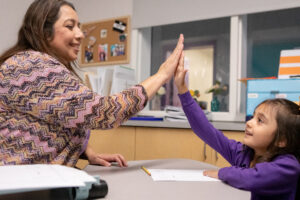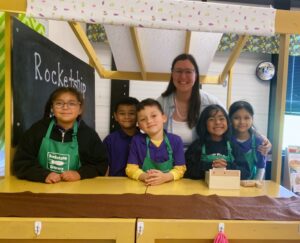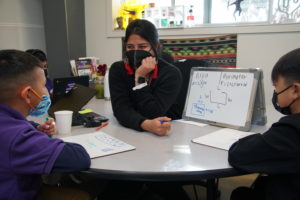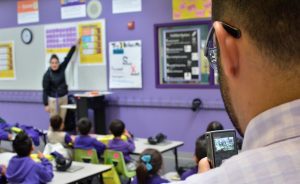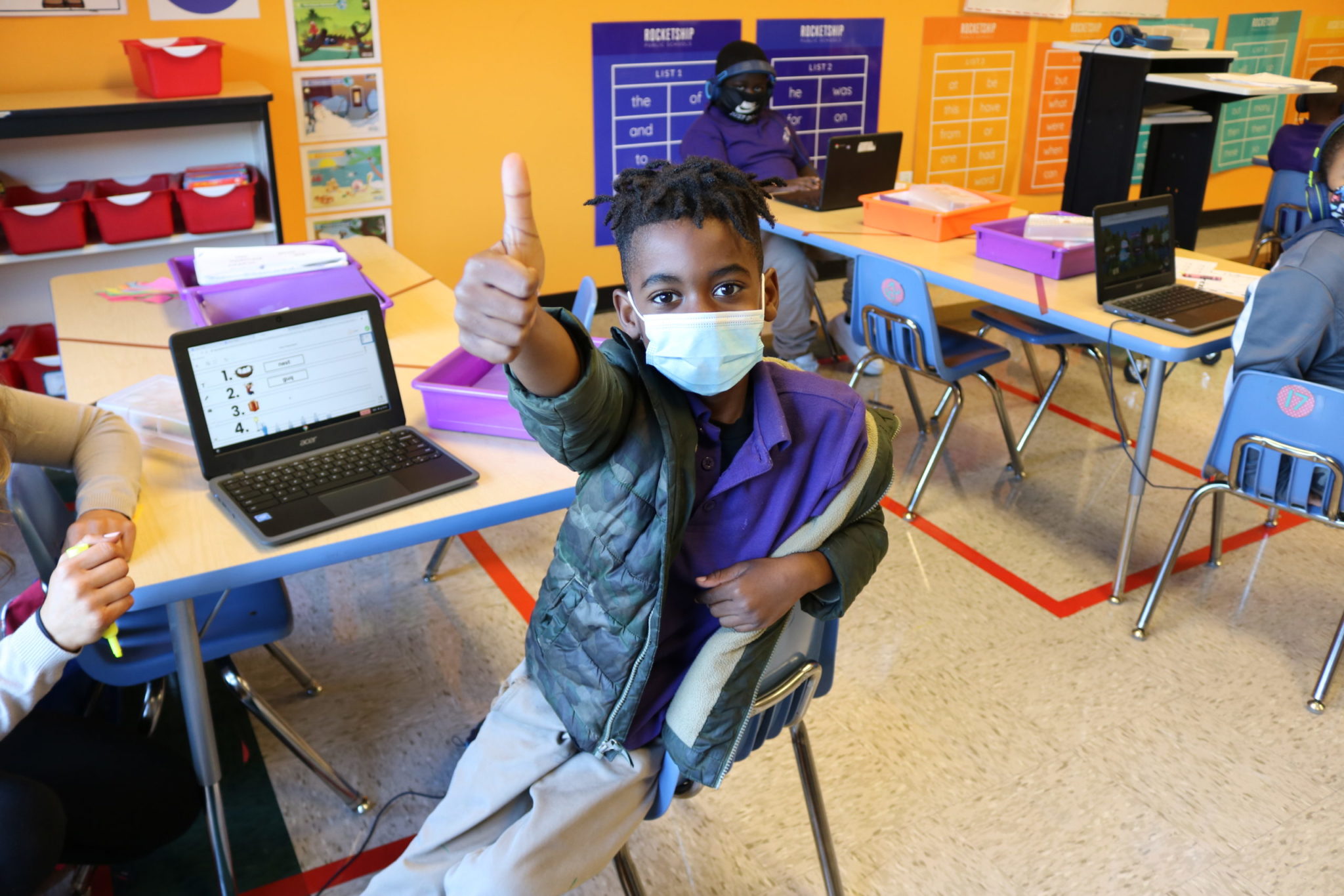
3 Ways to Ease the Transition Between Virtual and In-Person Classrooms
By James Cross, 4th Grade Teacher, Rocketship Nashville Northeast Elementary
Halfway through the 20/21 school year and we have schools that are still virtual, schools that are hybrid, and schools that went back in-person. My school is still 100% virtual for this school year, but a few months ago we invited a small number of students from each grade for in-person tutoring. And to be honest, it was not a walk in the park.
On my first day of in-person tutoring, I had a few students who I have taught and a few students who were new to me. I felt like a first-year teacher all over again. I was cold, unsure, and everything I had ever learned as a teacher was out of sight, out of mind. The transition won that day and I knew I couldn’t let this be the narrative. To turn this transition into a success, I adjusted my attention to focus on a few key areas – my communication, taking things back to the basics, and an internal audit on myself.
Communicate Honestly and Communicate Often
I’ve received countless texts, calls, and emails from parents who are confused or just need more information this year. This isn’t a new phenomenon, but it has been extremely difficult to make sure that all parents get the information that they need. And, truthfully, the information we share this year isn’t always positive or reaffirming news. We do, however, have an obligation to make sure we are communicating often and truthfully.
Most schools are sending out letters, calling, or emailing to notify parents of new and updated decisions. In early December of 2020, the largest district in Nashville went from in-person back to virtual with very short notice. The decision was made to keep students and families safe. I saw articles in the news, I heard about the decision on the radio, and I saw posts on their social media. The district did a great job of getting the message out to families. The conversation, however, can’t end there.
This school year has been a test of our ability to invest in people. We can’t control how others feel about the transition, but we can extend our ears. Call your families. Make sure they know about the transition. Ask for their thoughts. Check-in with them and see how things are going. You might not be able to solve anything, but families deserve to know that we care about them and their voices are important. A quick check-in might be the best way to help them understand the decision and clear up any questions or fears. After you’ve talked to families, talk to your students. They deserve a space to process, as well. It’s ok to be reassuring, but be honest. School is different right now, we can’t pretend it’s not.
Practice Doesn’t Make Perfect, But It Helps
We’ve all heard the saying that practice makes perfect. Let’s be honest though, practice doesn’t make us perfect, but practice makes things feel routine. As teachers, we’re experts on routines. We have routines for walking, sharpening a pencil, asking for water. You name it and we’ve got a routine for it. This is no different when teaching virtual or in-person. Cling to your routines that have been working and practice ones that will inevitably change when making a transition.
The first month of school is not the only month we should be practicing routines. If your students are going back into the classroom, tell them the new procedures in advance. When the students arrive at the building, practice the new procedures. You aren’t wasting instructional time, you are ensuring safety. If you are heading back to virtual classrooms, pull out those engagement techniques you used to prepare students before.
Not only should you practice, but let your students own the practice. Our students are not blind to what is happening and many of them want to share what they know or what we should be doing. Ask them about how and when they wear masks. Let them lead a conversation on hand washing. If they aren’t getting it, jump in and move the conversation in the right direction, but open the floor. Once again, be honest. They are going to be curious about all the new procedures and why they have to practice. We always owe our students the truth.
Celebrate Hard
It’s not easy to find the positive right now. The first time some of my students came back to the building for in-person tutoring, I struggled. I wanted to hug them. I wanted to sit on the carpet and share. I wanted to lay in the classroom library and dust off the books. I knew this wasn’t going to be a reality and so did my kids. They all walked in, sat at their 6-feet apart desks, and checked their masks. I didn’t know if I should circulate the room or if I was isolating myself or what I should do.
My students immediately broke the ice. Their faces were beams of happiness and they wanted to do work. They yearned for our first novel study or language board. I had a decision to make. I could either operate in a place of confusion or just embrace the flow. I chose to let things be what they will be, and look for the positive in each interaction. It was a whole lot easier than I thought it would be, too!
I celebrated students for anything and everything. You remembered your computer charger today, great job! You tried your best on our quick write, I am so proud of you! The fact is we all need a cheerleader right now. And we know that celebrations are the best way to remind our students what they should be doing. And it works! My students now always remember to get hand sanitizer when they walk in or out of the room because we chose to celebrate that action. The key is that you celebrate them honestly. If you are truly excited for them, they will recognize it and repeat the action.
As educators, we aren’t always in a position to make the decisions, but we are in a prime position to ensure that wherever our classroom is, whether virtual, in a school building, or both, we are making these transitions as smooth as possible for our students.
Published on January 15, 2021
Read more stories about: Uncategorized.
Back In The Classroom
First Year Teacher? Here are Five Mistakes to Avoid.
Jeremiah David, Paraprofessional, Rocketship Dream Community Prep | November 1, 2024
See what mistakes most first year teachers make and how you can get ahead this school year with some simple tips from a fellow educator.
Read more ⟩3 Classroom Systems New Teachers Swear By
Rocketship Public Schools | Sept. 30, 2024
As a first year teacher, establishing a smooth and productive classroom environment can feel a tad overwhelming. Thankfully, these simple strategies can go a long way.
Read more ⟩How Co-Teacher Collaboration Can Benefit Your Classroom
Featuring Alejandra Chavez, Education Specialist at Rocketship Mosaic Elementary | June 10, 2024
Hear from Ms. Aly about how a small team of educators can make a big difference in student outcomes through thoughtful planning, focused collaboration, and personalized accommodations. Ms. Aly was one of our highest-performing educators in California for the 23-24 school year.
Read more ⟩How to Spark Joy in ESL Classrooms with a Multilingual Learning Clubhouse
Featuring Ms. Amy De La Rosa, Multilingual Specialist, Nashville Northeast Elementary | June 1, 2023
Listen in to an audio interview with Amy De La Rosa, a Multilingual Specialist who has worked as an educator for over 14 years and found an innovative way to help her students learn English in a more accelerated, playful way.
Read more ⟩Supporting Parents of Multilingual Students in Family/Teacher Conferences
Emma Volpe, Rocketship United Academy | June 1, 2022
Get thoughtful insight on how to create a more inclusive family-teacher conference environment.
Read more ⟩5 Ways to Strengthen Relationships in the Classroom
James Cross, Assistant Principal, Rocketship Nashville Northeast Elementary | February 20, 2022
A new age of education calls for a new level of connection. Here are some key tips to strengthen relationships in your classroom this school year.
Read more ⟩5 Ways School Leaders Can Coach and Support Teachers
Eesir Kaur, Director of Professional Development | October 15, 2020
Are you a school leader looking to coach your teachers more effectively? Here's what works for us.
Read more ⟩



